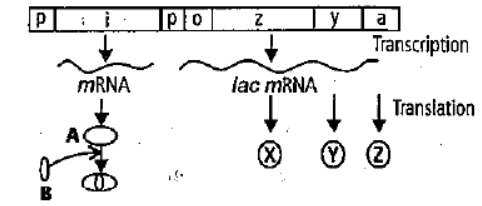
The given figure shows lac operon model and its functioning. Select the option which correctly labels A, B, X, Y and Z marked in the figure and also identify the label (L) which is primarily responsible for the hydrolysis of the disaccharide, lactose, into galactose and glucose.

A. A- Repressor, B- Inducer, X- beta galactosidase, Y- permease
B. Repressor, inducer, permease, beta galactosidase
C. Inducer, repressor, beta galactosidase, permease
D Inducer, repressor, beta galactosidase, transacetylase

Answer
364.2k+ views
Hint: A single-promoter operon, or group of genes, is the lac operon (transcribed as a single mRNA). The operon's genes produce proteins that enable the bacterium to utilize lactose as a fuel source.
Complete step by step solution:
Both mechanisms can be seen in the lac operon. It is a negative control system because the lac repressor, an active repressor that prevents transcription, usually prevents expression. The lac repressor interacts with the operator region to bind and inhibit transcription. The lac operon is made up of the three coding regions LacZ, LacY, and LacA.
The lacZ gene produces the -galactosidase enzyme that breaks down lactose. Lactose is transported into cells via the lacY gene product, lactose permease, while the lacA gene product, lactose acetylase, performs an unidentified and typically optional function. Operons can be either inducible or repressible. Because the lac operon is typically shut off (repressed), but can be activated in the presence of the inducer allolactose, it is referred to as an inducible operon.
A is a repressor that binds to the inducer region in the absence of lactose; in the presence of lactose, the inducer protein binds to the repressor. The lactose operon gene in E. coli is a polycistronic gene. Lactose is converted to glucose and galactose by the enzyme X-, a galactosidase.
A transporter protein called Y-permease moves lactose from the media into the cell. Z- is a transacetylase that converts acetyl CoA into -galactosidase.
So, option (A) is correct.
Note:
One of the most well-known gene regulatory networks is the lac operon, which serves as a historical illustration of how bacteria adjust their metabolism to different dietary environments. Since it is almost always present in Escherichia coli strains, its phenotype—the capacity to eat lactose—justifies usage in species identification.
Complete step by step solution:
Both mechanisms can be seen in the lac operon. It is a negative control system because the lac repressor, an active repressor that prevents transcription, usually prevents expression. The lac repressor interacts with the operator region to bind and inhibit transcription. The lac operon is made up of the three coding regions LacZ, LacY, and LacA.
The lacZ gene produces the -galactosidase enzyme that breaks down lactose. Lactose is transported into cells via the lacY gene product, lactose permease, while the lacA gene product, lactose acetylase, performs an unidentified and typically optional function. Operons can be either inducible or repressible. Because the lac operon is typically shut off (repressed), but can be activated in the presence of the inducer allolactose, it is referred to as an inducible operon.
A is a repressor that binds to the inducer region in the absence of lactose; in the presence of lactose, the inducer protein binds to the repressor. The lactose operon gene in E. coli is a polycistronic gene. Lactose is converted to glucose and galactose by the enzyme X-, a galactosidase.
A transporter protein called Y-permease moves lactose from the media into the cell. Z- is a transacetylase that converts acetyl CoA into -galactosidase.
So, option (A) is correct.
Note:
One of the most well-known gene regulatory networks is the lac operon, which serves as a historical illustration of how bacteria adjust their metabolism to different dietary environments. Since it is almost always present in Escherichia coli strains, its phenotype—the capacity to eat lactose—justifies usage in species identification.
Recently Updated Pages
Given diagram showing a typical agarose gel electrophoresis class 13 biology NEET_UG

Capping is a process in which A adenylate is added class 12 biology NEET_UG

Explain in brief the separation and isolation of DNA class 12 biology NEET_UG

Number of testicular lobules in testes is A 250 B 500 class 12 biology NEET_UG

Master Class 12 Business Studies: Engaging Questions & Answers for Success

Master Class 12 Economics: Engaging Questions & Answers for Success

Trending doubts
What is BLO What is the full form of BLO class 8 social science CBSE

Which places in India experience sunrise first and class 9 social science CBSE

Differentiate between an exothermic and an endothermic class 11 chemistry CBSE

The shortest day of the year in India

What are the major means of transport Explain each class 12 social science CBSE

Which are the Top 10 Largest Countries of the World?




